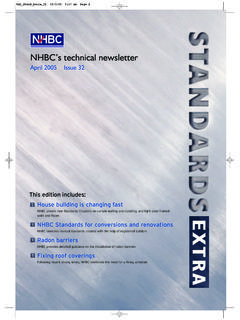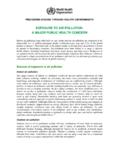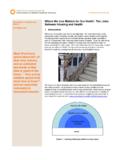Transcription of Consumer’s Guide to Radon Reduction - US EPA
1 EPA 402/K-10/005 | March 2013 | Consumer s Guide to Radon Reduction How to Fix Your Home Indoor Air Quality (IAQ) A Consumer s Guide to Radon Reduction OVERVIEW Reduce Radon Levels in Your Home Radon is the leading cause of lung cancer for non-smokers and the second leading cause of lung cancer for the general population. The Surgeon General and EPA recommend testing for Radon and reducing Radon in homes that have high levels. Fix your home if your Radon level is confirmed to be 4 picocuries per liter, pCi/L, or higher. Radon levels less than 4 pCi/L still pose a risk, and in many cases may be reduced.
2 If you smoke and your home has high Radon levels, your risk of lung cancer is especially high. Select a State Certified and/or Qualified Radon Mitigation Contractor Choose a qualified Radon mitigation contractor to fix your home. Start by checking with your state Radon office. Many states require Radon professionals to be licensed, certified, or registered. You also can contact private Radon proficiency programs for lists of privately certified Radon professionals in your area. See pages 4 and 17 for more information. Radon Reduction Techniques W ork Radon Reduction systems work. Some Radon Reduction systems can reduce Radon levels in your home by up to 99 percent.
3 Most homes can be fixed for about the same cost as other common home repairs. Your costs may vary depending on the size and design of your home and which Radon Reduction methods are needed. Get an estimate from one or more qualified Radon mitigation contractors. Hundreds of thousands of people have reduced Radon levels in their homes. Maintain Your Radon Reduction System Maintaining your Radon Reduction system takes little effort and keeps the system working properly and Radon levels low. See page 13 for more information. 3 INTRODUCTION his booklet is for people who tested their home for Radon and have elevated Radon levels 4 pCi/L or higher.
4 This booklet can help you: Select a qualified Radon mitigation contractor to reduce the Radon levels in your home. Determine an appropriate Radon Reduction method. Maintain your Radon Reduction system. Your state Radon office can provide information on how to test your home or how to locate a qualified Radon professional EPA s A Citizen s Guide to Radon and The Home Buyer s and Seller s Guide to Radon have information on Radon testing. Both documents are available at T 2 A Consumer s Guide to Radon Reduction R R A HOW Radon ENTERS YOUR HOME adon is a naturally occurring radioactive gas produced by the breakdown of uranium in soil, rock, and water.
5 Air pressure inside your home is usually lower than pressure in the soil around your home s foundation. Because of this difference in pressure, your home acts like a vacuum, drawing Radon in through foundation cracks and other openings. Radon also may be present in well water and can be released into the air in your home when water is used for showering and other household uses. In most cases, Radon entering the home through water is a small risk compared with Radon entering your home from the soil. In a small number of homes, the building materials such as granite and certain concrete products can give off Radon , although building materials rarely cause Radon problems by themselves.
6 In the United States, Radon gas in soils is the principal source of elevated Radon levels in homes. Radon IS A cancer -CAUSING, RADIOACTIVE GAS adon is estimated to cause tens of thousands of lung cancer deaths each year. In fact, the Surgeon General has warned that Radon is the second leading cause of lung cancer in the United States. Only smoking causes more lung cancer deaths. If you smoke and your home has high Radon levels, your risk of lung cancer is especially high. WHAT DO YOUR Radon TEST RESULTS MEAN? ny Radon exposure has some risk of causing lung cancer . The lower the Radon level in your home, the lower your family s risk of lung cancer .
7 The amount of Radon in the air is measured in pCi/L. 3 The Congress has set a long-term goal that indoor Radon levels be no more than outdoor levels; about pCi/L of Radon is normally found in the outside air. EPA recommends fixing your home if the results of one long- term test or the average of two short- term tests show Radon levels of 4 pCi/L or higher. With today s technology, Radon levels in most homes can be reduced to 2 pCi/L or below. You also may want to consider fixing if the level is between 2 and 4 pCi/L. A short-term test remains in your home for two days to 90 days, whereas a long-term test remains in your home for more than 90 days.
8 All Radon tests should be taken for a minimum of 48 hours. A short-term test will yield faster results, but a long-term test will give you a better understanding of your home s year-round average Radon level. EPA recommends two categories of Radon testing. One category is for concerned homeowners or occupants whose home is not for sale; refer to EPA s pamphlet A Citizen s Guide to Radon for testing guidance. The second category is for real estate transactions; refer to EPA s pamphlet Home Buyer s and Seller s Guide to Radon , which provides guidance and answers to some common questions. Both documents are available at http://www.
9 SELECTING A Radon TEST KIT Since you cannot see or smell Radon , special equipment is needed to detect it. When you re ready to test your home, contact your state Radon office for information on locating qualified test kits or qualified Radon testers. You also can order test kits and obtain information at org. There are two types of Radon testing devices. Passive Radon testing devices do not need power to function. These include charcoal canisters, alpha-track detectors, charcoal liquid scintillation devices, and electret ion chamber detectors.
10 Both short- and long-term passive devices are generally inexpensive. Active Radon testing devices require power to function and usually provide hourly readings and an average result for the test period. These include continuous Radon monitors and continuous working level monitors, and these tests may cost more. A state or local official can explain the differences between the devices and recommend ones that are most appropriate for your needs and expected testing conditions. Make sure to use a Radon testing device from a qualified laboratory. 4 A Consumer s Guide to Radon Reduction E E WHY HIRE A CONTRACTOR?















